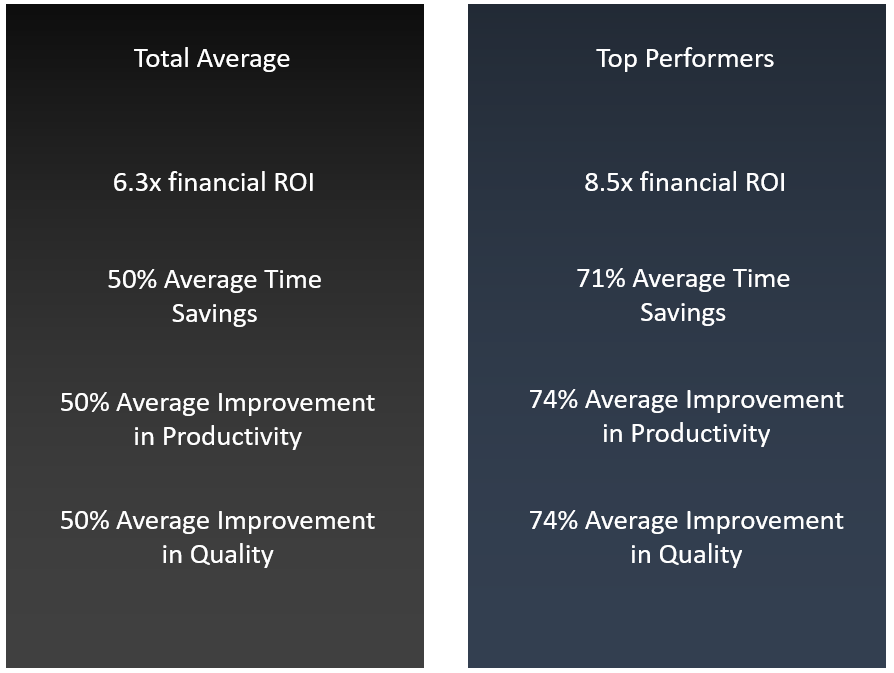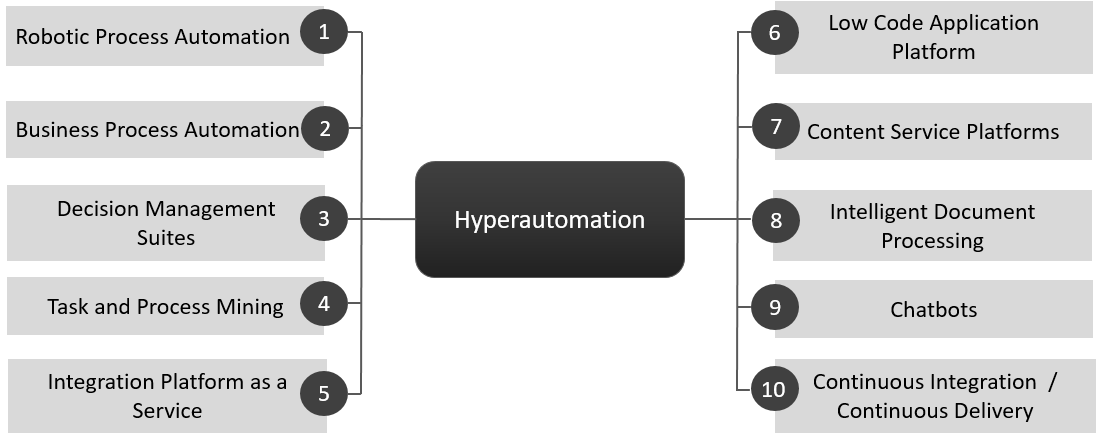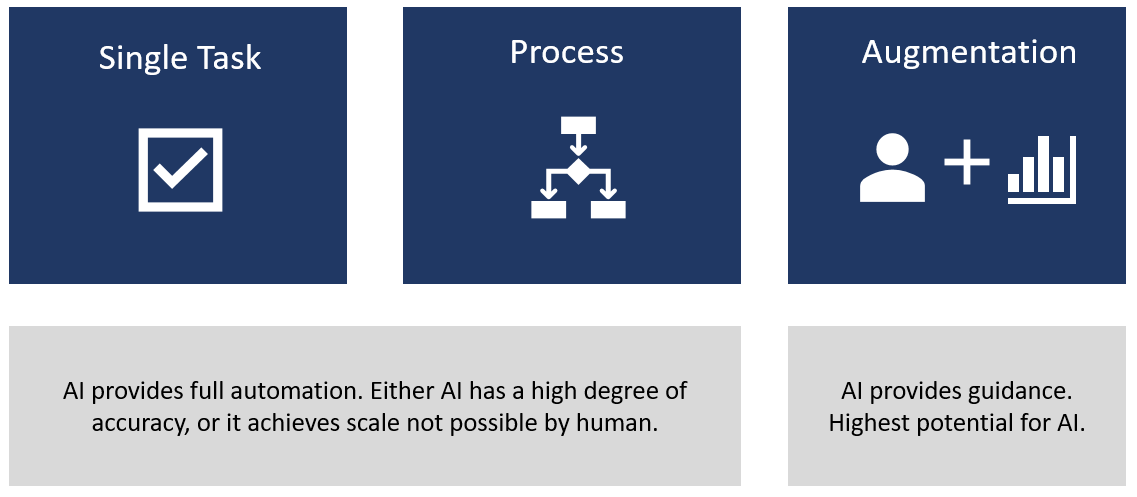Thriving in Economic Uncertainty with Hyperautomation

Thriving in Economic Uncertainty with Hyperautomation
The current economic uncertainty and inflation-related challenges are exerting pressure on organizations across industries. Finding ways to be more efficient is not just optional any more. Automation is emerging as a key tool to both overcome the current economic uncertainty and to ensure more resilient growth in the future.
The Potential of Automation
According to a McKinsey & Company report [1] 60% of all occupations have at least 30% of activities that can be automated. The top industries based on their potential for automation are:

Not only is the potential to automate a variety of activities undeniably there, automation also carries a significant ROI. A recent market research report conducted by Futurum research and Automation Anywhere shows among other things an average 6.3x financial ROI and an average 50% boost in productivity:

A distinction here is made between the average impact and the impact for companies that are top performers and have a stronger company-wide focus on automation. For top performers the average financial ROI is 8.5x and the average boost in productivity is 74%.
Hyperautomation: A Strategic Approach To Automation
"Hyperautomation" sounds like a new made-up word with "hype" baked right into it. The perception of the term is unfortunate, because the reality of what it represents is rooted in real value.
Due to internal pressures to deliver immediate value, the typical approach is to apply Robotic Process Automation (RPA) on isolated use cases. However, this siloed approach to automation typically does not provide the same long-term benefits one would get from a more holistic approach [3]. RPA is only one out of many technologies that can be leveraged for automation.
Hyperautomation is an enerprise-wide strategic approach to automation where on one side the activities across the entire organization are taken into consideration, on the other side a wide variety automation technologies are evaluated. The result is a strategic enterprise-wide road-map for automation that takes into consideration all activities that can be automated and aligns them with just the right automation technology.
Among the automation top performers referenced in the previous section 77% are implementing automation across the enterprise [2].
Overview of Automation Technologies
Available automation technologies go far beyond just RPA software. There are tools for automating entire workflows, extracting information from documents, even chatbots. Understanding the best use cases for each can be overwhelming.

-
Robotic Process Automation (RPA): The use of software robots or bots to automate repetitive and manual tasks. RPA tools can automate tasks such as data entry, document processing, and customer service inquiries.
Integration Platform as a Service (iPaaS): Cloud-based platforms that enable organizations to integrate various applications, data sources, and systems. iPaaS provides a central platform for managing data integration, application integration, and business process integration.
Low-Code Application Platform (LCAP): Platforms that allow organizations to develop, deploy, and manage applications without having to write code. LCAPs provide drag-and-drop interfaces and pre-built components that can be used to create custom applications.
Decision Management Suites (DMSs): Platforms that help organizations automate decision-making processes. DMSs use machine learning, artificial intelligence, and other cognitive technologies to automate decision-making processes, such as customer service inquiries, loan approvals, and claims processing.
Task Mining and Process Mining: Technologies that help organizations automate and optimize complex processes. Task Mining helps organizations to identify and automate repetitive and manual tasks, while Process Mining helps organizations to understand and optimize complex processes.
Content Service Platforms: Platforms that help organizations automate and manage content-centric processes, such as document processing, records management, and content collaboration.
Business Process Automation (BPA): The use of technology to automate end-to-end business processes. BPA automates the entire workflow while RPA is concerned with individual tasks that can be fed to a bot.
Intelligent Document Processing (IDP): The use of artificial intelligence and machine learning to automate the processing of structured and unstructured documents. IDP helps organizations to automate document-centric processes, such as invoice processing and HR on-boarding.
Chatbots: Computer programs designed to mimic human conversation and provide automated customer service. Chatbots use natural language processing (NLP) and machine learning algorithms to understand and respond to customer inquiries in real-time.
Continous Integration / Continous Delivery (CI / CD): Methodology and tools that introduce automation into every aspect of the internal software development life-cycle. CI/CD specifically enables automated testing and quality assurance.
How AI Drives Value in Automation
RPA is widely used because it has the capacity to automate simple tasks and do it reliably. A simple task might be copying documents or running reports. The steps are all determined, a rule-based program is used to execute them.
The promise of AI is that we can automate a lot more complex activities. The challenge however is that there are very few AI applications where the models perform as well or better than a human. Typically AI models make more mistakes than humans. This means for tasks that need to work reliably and correctly we can't always use AI for full automation.
AI is used for full automation of tasks and processes when the performance is comparable to a human. Another reason can be because the scale of the AI output justifies any costs associated with added errors
Examples of tasks where AI is used for full automation include
-
Reading of addresses on envelopes by the US postal service
Counting and sorting products on assembly lines
Video monitoring of warehouses for hazards
In the envelopes and assembly line use cases the AI models used are as good or better than humans. In the monitoring use case a human is usually better in making visual assessments. However, a single human can't monitor an entire warehouse day and night. AI is used for full automation, even though it may not be perfect, because the human alternative is not scalable.

Achieving full automation, while lucrative, is non-trivial for most complex activities. However if we focus on assisting or augmenting a human it opens up a door for a lot of opportunities. One can assess what aspects of the activity an AI model can perform well, and then use AI models only for that aspect of the activity.
Also if the AI provides guidance with a human in the loop usually there is also more tolerance to errors. This means we can use AI models, even if their performance is not better than human, as long as they are providing value and saving time.
At Reliancy we have seen the biggest impact on automation in augmentation. In one of our use cases we utilized computer vision to aid cost estimators in the oil and gas industry. After semi-automating the process of extracting a bill of materials from a schematic pdf drawing the output of cost-estimators went up by 100x fold.
References
[1] A Future That Works: Automation, Employment, and Productivity. McKinsey Global Institute. January 2017
[2] Automation Now Next. Futurum Research, Automation Anywhere. September 2022.
[3] Beyond RPA: Build Your Hyperautomation Technology Portfolio. Gartner. October 2021.